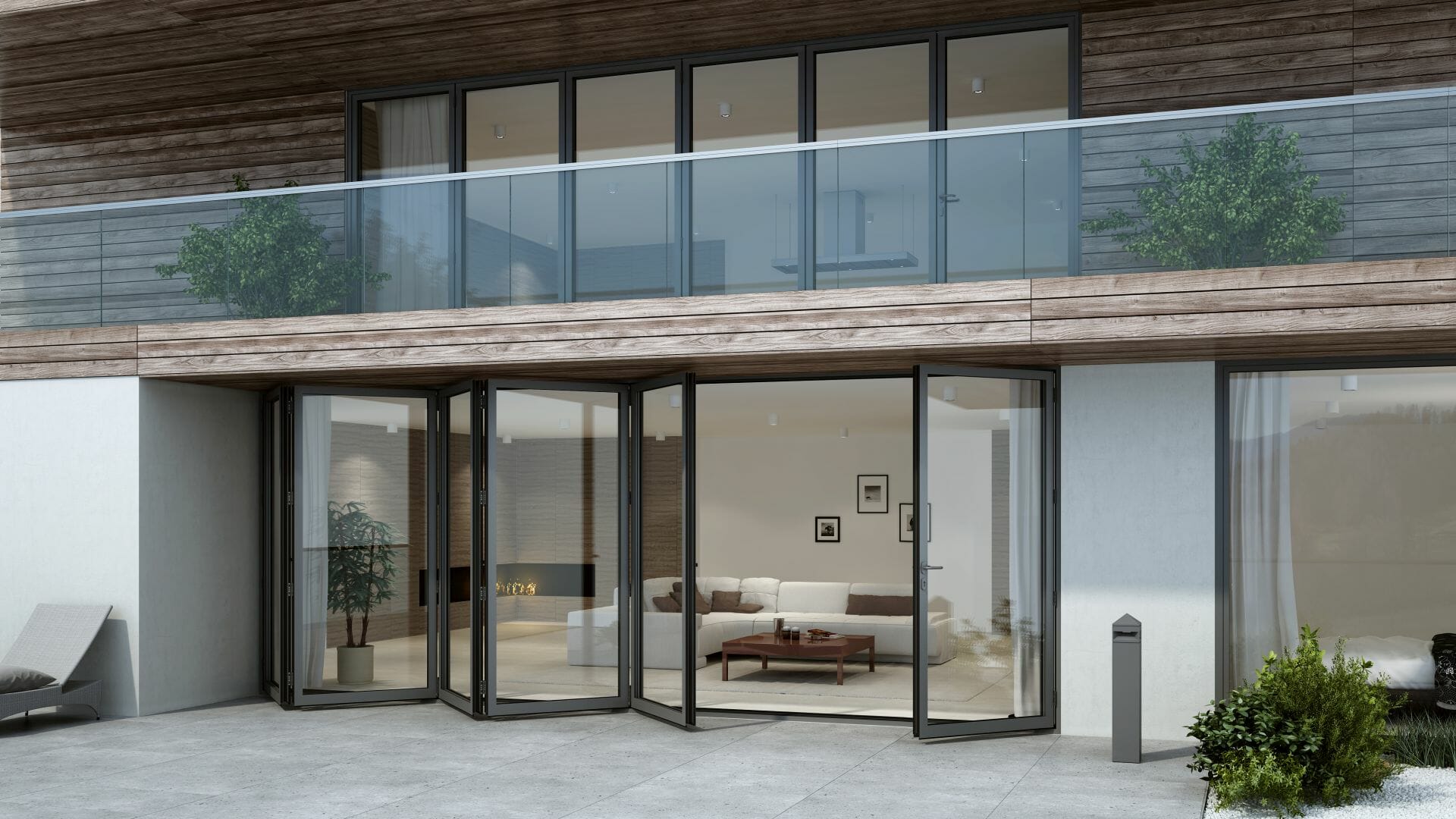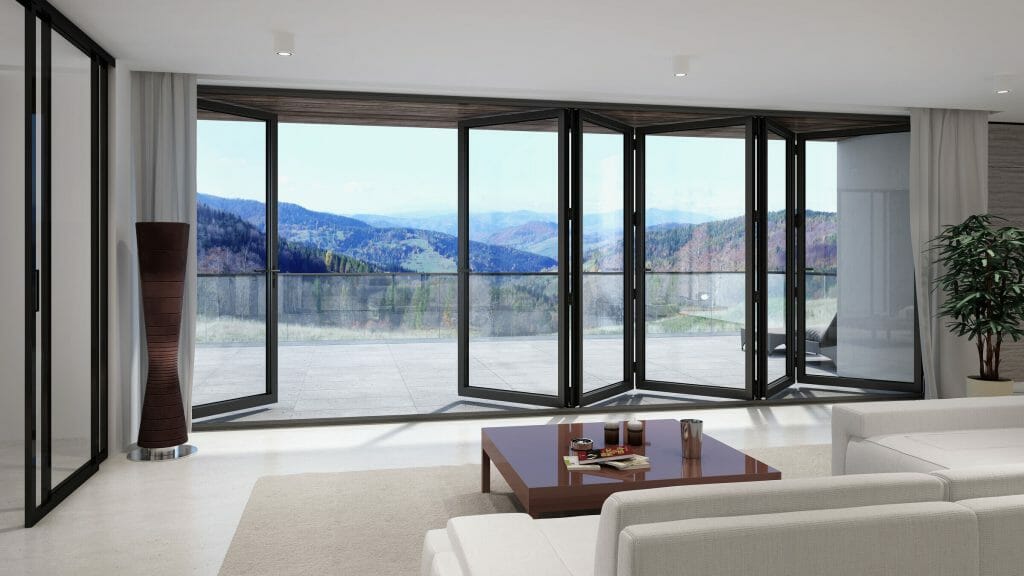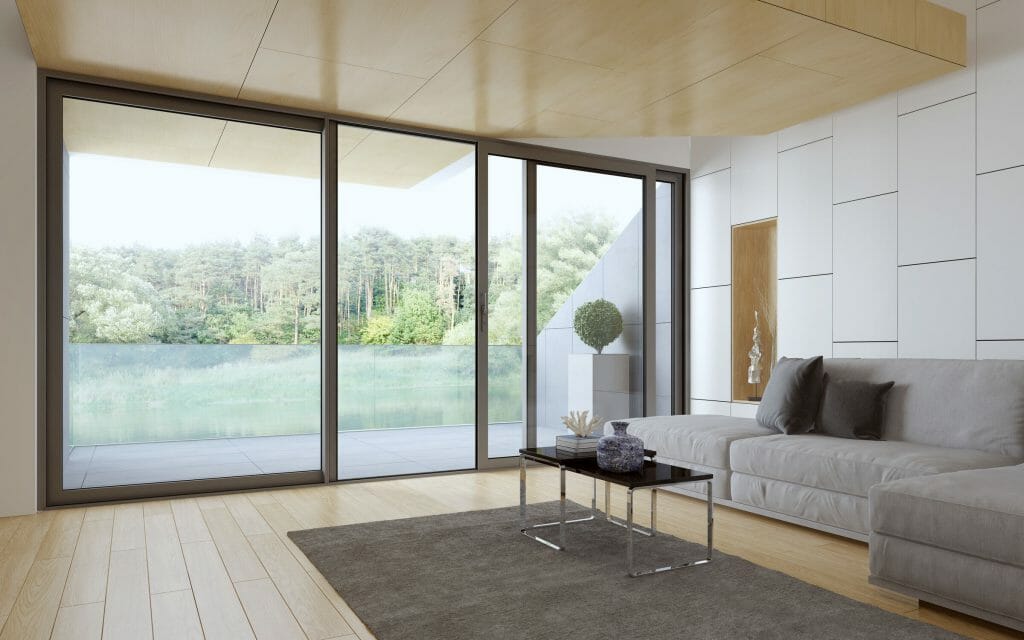
By Wojciech Brozyna – MD of Aluprof UK
There are several design choices when considering the specification of sliding doors for use in a city high rise or in a typical residential setting. Not only are the opening styles important to suit the clients’ needs, but there are also choices which will make the door both look and perform better for longer, if specified correctly.
The types of sliding door can be broken down into two basic operational functions, these can be simple inline sliding, or folding sliding. Inline sliding doors consist of large sliding panels which slide within the door reveal to open the room up to the outside. In their most basic form, they are two sliding panels, normally with one fixed and one sliding. Along with the basic sliding doors, there are ‘tilt and slide’ doors and ‘lift and slide’ doors. These doors offer higher weather ratings than the basic sliding door systems. The ‘tilt and slide’ is basically a large open-in sash which is fully sealed with a centre seal and is locked with multiple points around the frame. The hardware allows the panel to open in and then slide to one side behind the fixed panel. The ‘lift and slide’ offers a lift facility with a large handle once operated lifts the sliding panel up very slightly off the bottom seals and then allows the panel to slide with little effort. These systems can be specified with 2, 3 or 4 tracks allowing the door panels to stack behind each other within the door reveal. There is also the option to hide the door panel or panels into a side wall given the space, to offer an almost clear opening.
Sliding folding arrangements allow the doors to ‘concertina’ open, offering an almost clear opening. Doors are stacked perpendicular to the track, either on one side or both sides, depending on their design. These doors can either stack internally or externally, again, depending on the design option. Because of their frame design and ease of installation, they are often specified in home improvement applications.
Crucial to all large sliding door installations is the need to have a substantial structure to fix to on all sides. Often the head of the opening can cause issues, particularly on a wide door installation. If there is any settlement of a lintel or structure, this can cause issues with future operability. Live loads should also be considered to ensure that the sliding door does not bind in certain loading conditions. Colour can also become an issue, such as a dark door facing south, so expansion should be allowed for in the construction. Clear guidance should be sought on these issues from the systems company and structural engineer to ensure ease of operation.
Given the styles of door available, the choice comes down to visual appearance and practicality. Externally stacking sliding folding doors may not be suitable in a high-rise application due to limited space on a balcony. Sliding doors do offer more clear glazing per opening with much less aluminium visible but may not offer a full opening. With more available outdoor space, sliding folding doors are often chosen for home improvement or new traditional home build or grand designs type projects.
Weather performance is crucial, especially in high rise applications. Basic sliding doors often will not meet the exposure requirements of a high rise location but lift and slide doors that rely on their weight once closed to rest weather seals, can offer exceptional weathering capability. Aluprof’s MB-77HS system, for example, offers an impressive maximum Class 4 air tightness when tested to BS EN 12207 and a Class 9A (600Pa) for watertightness when tested to BS EN 12208. This door has also been successfully tested to CWCT standards when used within a high rise facade and is possibly the door style most often chosen by specifiers for high rise use.
Key for most designers and specifiers on high rise applications is the threshold arrangement which is to be kept as low as possible in order not to create a trip hazard. Basic sliding doors and tilt and slide doors will need some form of step or visible frame at the threshold, but the lift and slide only needs a low, or flush threshold, with a groove for a guided roller, the weather seals being carried in the sliding panel. The choice is with the specifier, but the lift and slide door option offers the best combination of ease of use, best use of space, flush threshold, high weather rating and minimal maintenance requirements. Aluprof provide examples of robust detailing to ensure both weathering and thermal performance Ian each product technical manual.
In a traditional residential application sound attenuation may not be an issue, but on high rise, particularly on lower levels, an acoustic glass may be required. It is possible to specify systems which can accept thicker acoustic glazing at lower floors and on upper floors revert to a more traditional double or triple glazed unit. This can often be accommodated in one design of a sliding door system. Sound attenuation may also be required through any trickle vents so the accommodation of these larger vents will need to be considered when specifying a sliding door system.
With the Future Homes consultation suggesting much lower heat transfer (U values) for doors by 2025, a well insulated systems frame design and capability to carry high performance triple glazed units should be considered. The MB-77HS lift and slide system, for example, can offer a very high insulation capability of up to 0.84 W/(m2K). Consideration should also be made for the replacement of glazing and decided if external or internal glazing is to be adopted.
All sliding doors are well equipped today with quality locks that meet PAS 24, however for traditional residential applications at ground floor level, possible additional security is required dependent on the location. Remote control options are also becoming more popular on sliding doors where doors can be opened from a remote control or an application on a smart device. As with all user operated devices, at some time in the future, all doors will require some form of maintenance. It is worth considering this regarding the availability of parts so, choosing a systems company of repute, such as Aluprof, would be strongly advised.
Where space is at a minimum, particularly on high rise applications, there are options of Juliet balconies being specified, but consideration over access for cleaning and maintenance also needs to be considered.
A very wide range of finishes are available today along with colours realistic woodgrain effect coatings are available and the ability to dual colour with an inside and outside colour option. Whichever is chosen a minimal cleaning regime should be specified so that the finish will offer a lifetime of use.
Crucial to correct specification of these sophisticated systems, it is recommended to always contact a specialist when looking to specify sliding systems for either city high rise or typical residential setting. Getting the design choices right at start can save both a great deal of time and cost later down the project timeline. Here at Aluprof UK we have a team of dedicated support technicians just a phone call or email away.
Since setting up the Aluprof Office at the Business Design Centre in London, the company has rapidly grown their specification influence in the UK with their high-performance architectural aluminium systems. Further expansion of the company’s headquarters in Altrincham now provides specifiers with meeting facilities and an extensive showroom of commercial systems to view. With overseas growth across Europe spreading into the Middle East and firm roots already in the East of the USA, the company is becoming a global player in facade supply.
Further information is available on the company’s website at aluprof.co.uk or direct from their UK head office in Altrincham on 0161 941 4005.





